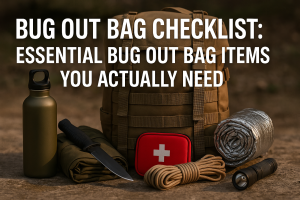IIntroduction to Long-Term Food Storage
In a world full of uncertainties, long-term food storage is one of the smartest investments a prepper can make. Whether you’re preparing for natural disasters, economic collapse, or extended power outages, having a well-stocked pantry ensures peace of mind.
But storing food for months, or even years, requires more than simply buying in bulk. It’s about knowing which foods last, how to preserve them, and how to store them properly for long-term use.
In this guide, we’ll explore proven strategies for building a reliable long-term food supply, from choosing the right packaging to maintaining ideal storage conditions.

The Science Behind Food Preservation
Understanding Spoilage and Shelf Life
Food spoils because of microorganisms, moisture, and exposure to oxygen. The key to long-term storage is minimizing these three factors. When moisture and oxygen are controlled, bacteria and mold have a much harder time thriving.
Factors That Affect Food Longevity
- Temperature: Cooler temperatures slow down spoilage.
- Humidity: Too much moisture encourages bacterial growth.
- Light: UV rays can degrade fats and vitamins.
Common Preservation Methods Explained
The main preservation techniques include drying, canning, freeze-drying, vacuum sealing, and fermenting. Each has its pros and cons depending on the type of food and storage duration.
Choosing the Right Foods for Long-Term Storage
Best Dry Goods for Long-Term Survival
Focus on staples like:
- Rice (white lasts longer than brown)
- Beans and lentils
- Oats
- Pasta
- Flour
- Sugar and salt
These have long shelf lives and are calorie-dense, ideal for survival situations.
High-Calorie and Nutrient-Dense Options
Foods rich in calories and nutrients sustain energy during stressful times. Think peanut butter, nuts, seeds, canned meats, and powdered milk.
Foods to Avoid for Long-Term Storage
Avoid high-fat, high-moisture items like:
- Fresh dairy products
- Soft cheeses
- Foods with artificial preservatives
They spoil quickly and can attract pests.
Food Storage Containers and Packaging
Mylar Bags vs. Vacuum Sealing
Mylar bags combined with oxygen absorbers are ideal for dry goods. Vacuum sealing works best for short-term refrigerated or frozen storage.
Using Oxygen Absorbers Correctly
Always check the oxygen absorber’s size based on your container’s volume. A good seal ensures oxygen stays below 0.01%, preventing spoilage.
Storing Bulk Foods Safely
Store Mylar-sealed bags inside food-grade plastic buckets for extra protection against pests and moisture.
Ideal Storage Conditions for Maximum Shelf Life
Temperature and Humidity Control
Keep storage rooms between 50°F–70°F (10°C–21°C) and under 50% humidity.
Light Exposure and Air Quality
Use dark, cool spaces like basements or pantries. Avoid direct sunlight.
Pest Prevention Techniques
Use bay leaves, diatomaceous earth, or airtight containers to repel bugs naturally.
How to Build a Sustainable Food Storage System
Inventory Management and Rotation
A well-organized system prevents waste and ensures your supplies stay fresh. Adopt the FIFO method (First In, First Out) — use the oldest items first and replace them with new ones.
Keep a simple spreadsheet or notebook log that includes:
- Purchase dates
- Expiration or “best by” dates
- Quantity and location of each item
This method keeps your food storage balanced and prevents accidental spoilage.
Labeling and Tracking Expiration Dates
Always label containers clearly with content names and packing dates. Use waterproof markers and date stickers for easy readability. For bulk storage, color-coded labels (e.g., red for grains, blue for canned goods) make identification quick during emergencies.
Creating a Long-Term Storage Plan
Start with your family’s daily caloric needs and multiply by 30 to plan for a month. Gradually build up to a 6-month or 1-year supply, focusing on a balanced mix of proteins, carbohydrates, and fats.
DIY Preservation Techniques for Preppers

Canning, Dehydrating, and Freeze-Drying
These three preservation methods are essential for preppers:
- Canning: Perfect for soups, meats, and vegetables. Pressure canners ensure safe preservation.
- Dehydrating: Removes moisture, extending shelf life for fruits, jerky, and herbs.
- Freeze-Drying: Retains 97% of nutrients and can last up to 25 years. While costly, it’s ideal for long-term emergency storage.
Homemade Jerky and Dried Fruits
Jerky is a lightweight, protein-rich food with a long shelf life. Marinate thin meat slices in salt and spices, then dry them using a dehydrator or oven at 160°F (71°C).
Similarly, dehydrate fruits like apples, bananas, and berries for natural, nutrient-packed snacks.
Root Cellaring Basics
Root cellars are the ultimate low-tech storage solution. They maintain cool, humid conditions ideal for root vegetables such as carrots, potatoes, and onions. Proper ventilation is key to prevent mold and rot.
Shelf-Stable Protein and Fat Sources
Canned Meats and Fish
Canned chicken, tuna, and salmon are rich in protein and can last up to 5 years. Rotate these every few years for freshness and store them away from direct sunlight.
Powdered Eggs and Milk
Powdered forms of dairy are excellent for baking and cooking during emergencies. Keep them sealed in air-tight Mylar bags with desiccants.
Long-Lasting Fats and Oils
Oils can go rancid, so choose shelf-stable options like coconut oil, ghee, and shortening. Store them in a cool, dark area to extend their lifespan.
Storing Fruits, Vegetables, and Grains
Best Grains for Storage
- White rice
- Hard red and white wheat
- Barley
- Quinoa
- Rolled oats
Store them in oxygen-free containers for up to 25 years.
Long-Lasting Produce Options
Vegetables like pumpkins, winter squash, and potatoes can last months if stored in cool, ventilated conditions. Fruits like apples and pears also fare well when kept in single layers with proper spacing.
Proper Storage Containers for Each Type
Use Mylar bags with oxygen absorbers for grains, and baskets or crates for fresh produce. Rotate produce regularly to prevent spoilage.
Emergency Food Kits and Commercial Options
Ready-Made Food Kits for Survival
Brands like Augason Farms, Mountain House, and Wise Company offer freeze-dried meals that can last 20–30 years. These kits are great for beginners or as supplemental food reserves.
Comparing MREs and Freeze-Dried Meals
- MREs (Meals Ready-to-Eat): Convenient, require no water, and last 5 years on average.
- Freeze-Dried Meals: Longer shelf life (20+ years) and retain more nutrients, but need boiling water to rehydrate.
How to Supplement with Homemade Supplies
Combine commercial kits with DIY options like home-canned goods and dried produce for diversity and cost savings. This balance ensures better nutrition and food variety during emergencies.
Common Mistakes to Avoid in Long-Term Food Storage
Improper Sealing and Moisture Issues
Poor sealing leads to oxygen leaks and mold growth. Always check seals twice and avoid storing food near heat or damp areas.
Overlooking Rotation
Failing to rotate your stockpile can cause waste. Set reminders every 3–6 months to inspect and replace items nearing expiration.
Ignoring Nutritional Balance
A pantry full of carbs isn’t enough. Include vitamins, minerals, proteins, and fats to sustain energy and health during crises.
Budget-Friendly Food Storage Strategies
Smart Bulk Buying
Buy staples like rice, beans, and oats in bulk from wholesale clubs or local co-ops. Look for sales during harvest seasons for maximum savings.
Using Coupons and Discounts
Many grocery chains and online retailers offer digital coupons for bulk purchases. Combine deals with loyalty programs for even deeper discounts.
Affordable DIY Preservation Ideas
Instead of buying expensive equipment, start small:
- Use your oven as a dehydrator.
- Reuse jars and containers from store-bought foods.
- Share costs with friends or family by bulk-buying together.
Maintaining and Updating Your Food Storage Over Time
Conducting Regular Inspections
Inspect your storage every 3–4 months for leaks, pests, or temperature fluctuations. Replace compromised items immediately.
Refreshing Old Stock
Use older supplies for daily cooking and replace them with newer stock. This keeps your emergency pantry constantly refreshed and usable.
Adjusting for Family Size and Dietary Needs
As family sizes or dietary preferences change (e.g., gluten-free or vegan diets), modify your storage plan accordingly to maintain balance and usability.
FAQs About Long-Term Food Storage
Q1: How long can I store rice and beans?
White rice and dry beans can last 25–30 years if stored in Mylar bags with oxygen absorbers in cool, dry conditions.
Q2: What is the best temperature for food storage?
Ideally between 50°F and 70°F (10°C–21°C) with low humidity and no direct sunlight.
Q3: Can I store water for years?
Yes, but it’s best to rotate every 6–12 months. Store in BPA-free containers and add purification tablets for safety.
Q4: Are freeze-dried foods healthier than canned goods?
Freeze-dried foods retain more nutrients and flavor but are more expensive. Canned goods are affordable and ready-to-eat.
Q5: How do I start my food storage on a budget?
Start small—buy one extra non-perishable item per grocery trip. Over time, your pantry will grow without straining your wallet.
Q6: How do I keep pests away from my storage?
Use airtight containers, bay leaves, diatomaceous earth, or natural repellents to protect against bugs and rodents.
Conclusion and Final Preparedness Checklist
Summary of Key Takeaways:
- Choose the right mix of foods for long-term storage.
- Control temperature, moisture, and light exposure.
- Rotate your stock regularly using the FIFO method.
- Label, organize, and inspect frequently.
- Stay consistent and adaptable.
A well-planned long-term food storage system doesn’t just secure your meals, it provides peace of mind, independence, and resilience in uncertain times.
Final Checklist:
✅ Store food in cool, dry, dark conditions
✅ Use Mylar bags and oxygen absorbers
✅ Maintain balanced nutrition
✅ Rotate supplies regularly
✅ Keep an updated inventory
🔗 For additional in-depth guidance on food preservation and preparedness, visit Ready.gov’s Food Storage and Safety Guide.





